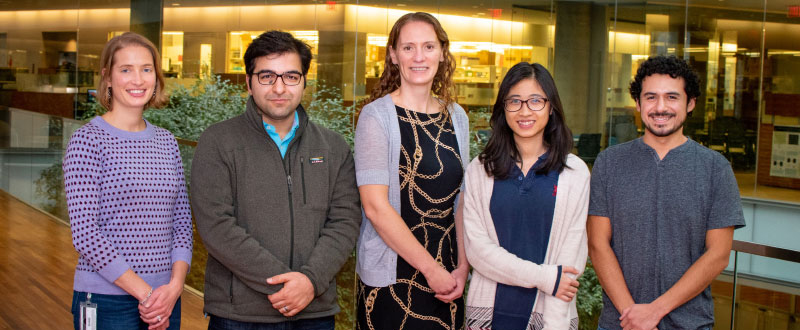
Quality control
Emerging cell therapies are giving hope to cancer patients. But to guide the process new analytical tools are desperately needed. Melissa Skala and her team are going all in.
There was a time when biomedical engineer Melissa Skala dreamed of becoming an astronaut. But at a young age a fascination with physics, and then with light, emerged. It was Lake Mendota that first drew Skala – a skilled sailor – to Madison.
Today, Prof. Skala leads the Optical Microscopy in Medicine Lab at the Morgridge Institute for Research. Her program is among the most diverse and dynamic on campus, bridging fundamental discovery to translation.
Her lab develops optical imaging techniques to shed light on some of the grandest challenges of human health – from personalized treatment plans to predicting preterm birth.
Fueled by multidisciplinary collaborations, much of Skala’s research takes aim at cancer, including breast, oral and pancreatic.
Skala’s current Accelerator project stems from a celebrated invention disclosure from 2018.
That year, Skala and collaborator Alex Walsh were awarded top WARF honors for an exciting discovery. Using sophisticated research-grade optical imaging, they found that they could distinguish activated immune T cells based on metabolites glowing faintly within them.
“That signal tells us about T-cell function, which is important for T-cell manufacturing,” Skala explains.
It was early stage, but clear that their work could be used to screen active immunotherapy cells from low quality ones, and thus provide vital support to emerging cancer treatments such as CAR T therapy.
In CAR T therapy, a patient’s T cells (so-called ‘soldiers of the immune system’) are removed from his/her body and engineered into cancer-targeting ‘super soldiers.’ Then they are reinjected into the patient.
Skala’s technology could be vital for quality control by evaluating cells prior to reinjection. It could answer critical questions such as: Does this patient have enough healthy immune cells? Is he or she likely to benefit from last line therapy?
Critical questions, says Skala, because these patients are some of the most vulnerable. And time is of the utmost essence.
CAR T cell therapies are given mostly to patients with B-cell cancers, both children and adults. These patients have endured chemotherapy and bone marrow transplants, and immunotherapy may be their last option.
“We’ve talked to lots of physicians and they say it’s hard to keep their patients alive long enough to get the T cells manufactured,” Skala says. “Currently it takes about five weeks from the time you draw the blood to get it back into the patient and they’re very sick already so it’s tough. We’re hoping to improve that process.”
Unlike competing technologies, Skala’s method does not destroy any of the cells during the evaluation process. Label-free and non-invasive, it could seamlessly integrate into the current biomanufacturing workflow because it uses only light to assess the cells.
There are some 500 CAR T therapies in clinical trials. It is still young science, and estimating time to market for a supporting technology like Skala’s is challenging.
But since 2018 Skala’s team has established across multiple human donors that autofluorescence – those ‘weak glows’ – can be used reliably to identify activated T cells. Now, WARF Accelerator support is helping the team develop a prototype based on these promising initial studies, validate the prototype in patient blood samples and ultimately commercialize a product.
Working with the Discovery to Product (D2P) program on campus has also been “a great experience.”
She says the team is in the throes of developing a prototype and “doing lots of market research in parallel” because there are multiple ways the technology could be deployed, such as a functional add-on to a microscope.
“We want to know what the eventual users would value,” she says. “The idea is to take this million-dollar research instrument that we took the original data on, and turn it into a prototype that is more reasonably priced so people can use it.”
Product development is new territory for Skala. She admits and embraces the challenge.
“We’re used to doing things like designing experiments and writing papers,” she says. “We’re used to following the science and letting it guide us. It’s a complete pivot to create a product. We know it’s important to get this out soon. The sooner the better. There’s just a sense of urgency.
“I’m going all in.”